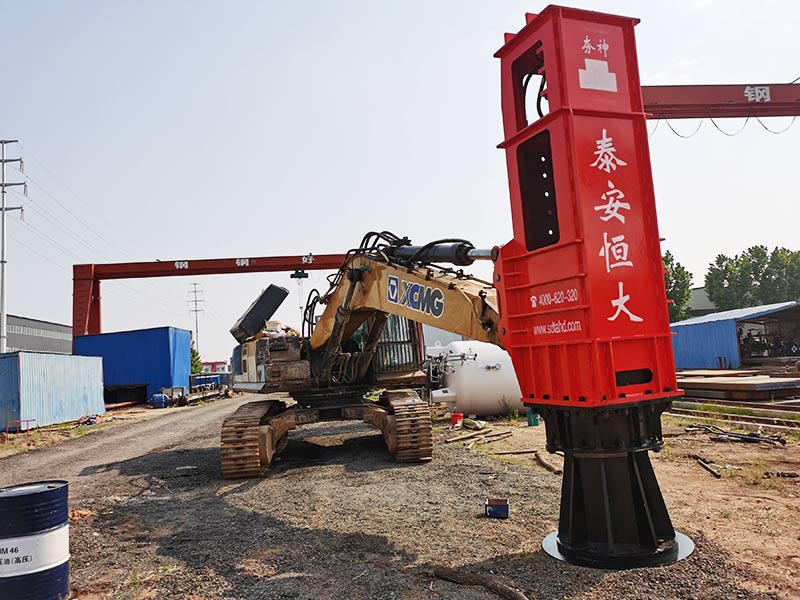What are the shallow compaction techniques?
- Update time:2023-01-29 15:43:46
- Views:356
Commonly adopted techniques for relatively shallow compaction include static or vibrating drum rollers, pad-foot rollers and plate compactors.The rapid impact compactor as a means of quickly repairing damage runways. It works by imparting dynamic energy through a falling 'drop-weight, which is dropped from a controlled height onto a patented foot.

Numerous developments of the last decades provide a broad range of near-surface compaction technologies (such as static and dynamic rollers) and deep compaction techniques (such as deep vibro-compaction, vibro-flotation and deep vibroreplacement, heavy tamping). However, until recently no device was available for middle-deep compaction. The lately introduced Rapid Impact Compactor (RIC) aims at closing the gap between the surface compaction methods and the deep compaction methods, and permitting a middle-deep improvement of the ground up to a depth of 4 to 10 m.

Rapid Impact Compaction provides a technically sound and economic method of improving the capacity of a wide variety of loose soils and fills. The Rapid Impact Compactor can work alone on some types of strata (effective treatment in the top layers of typically up to 6 m depth) or in conjunction with other ground improvement techniques, e.g., Deep Dynamic Compaction, where the strata´s depth or grain sizes dictates. Due to the numerous benefits, e.g., compaction control through an on-board computer, operation at safety, quality assurance, versatility and speed, the Rapid Impact Compaction system will become well-established in the dynamic compaction field. Further research, including theoretical, numerical and practical studies, is nevertheless essential to enhance the innovative compaction system.

Typical areas of application could include projects such as low-rise structures like housing and schools, embankments, roads and pavement areas. Having the Rapid Impact Compactor mounted on a tracked machine gives it the versatility to move about in narrow and limited height spaces, such as within existing warehouses. With regard to its mobility, the RIC is able to be transported as a single unit, with the impact foot removed and the front end lowered horizontally on a flat-bed trailer. The machine can be ready to work just a few minutes after off-loading. If road restrictions apply, the unit can be easily split into two loads with the excavator travelling separately from the hammer. Re-assembly is achieved in less than two hours.

The RIC, imparts energy by dropping a 5 to 9 tonne weight from a relatively small height of 1.2 m at a blow rate of 40 to 90 times a minute. Depending on the ram weight, the maximum energy delivered per blow is 59 to 106 kNm. Although the energy per blow is small compared to the conventional DC, the rapid blow frequency amply compensates, resulting in a greater power that varies between 2.4 to 6.4 MNm/min. Thus, a much greater total energy input per unit area of a site can be achieved with RIC. Moreover, the energy transfer of the RIC is far more effective due to its foot which stays in contact with the ground during the impact sequence.

With RIC the total energy input will have a major influence on the depth of compaction. With the rapid impact compactor the energy per blow is very much smaller than conventional DC and the fixed energy per blow of typically 8.4 t.m is not the major influence on the depth of compaction due to the progressive top down improvement of the treated ground. Of much greater significance to the effective depth of compaction is the number of blows at a compaction point or the energy applied overall to the ground surface. For typical impact spacing, 35 blows will impart about 170 tonne.m/m2 of energy. This level of energy input has produced significant compaction to depths between 3 and 4 m in non-engineered generally granular fill and up to about 3 m in natural sand and silty soils using a 7 t hammer.
- 2022-09-06What is the difference between rapid impact compaction and dynamic compaction
- 2022-08-15What is the appropriate depth of rapid impact compaction?
- 2022-12-23Why should I use rapid impact compaction ground improvement?
- 2023-02-09Should you wet dirt when compacting? - HENGDA RIC
- 2023-01-29What are the shallow compaction techniques?
- 2023-02-14How deep does a rapid impact compactor? - HENGDA RIC
- 2023-02-14How deep is rapid impact compaction? - HENGDA RIC
- 2022-08-13Rapid Impact Compaction History In China - RIC 夯神
- 2022-12-26What are the three types of compaction? HENGDA RIC
- 2023-02-09Rapid impact compaction ltd - HENGDA RIC
- 2022-08-15What is Rapid Hydraulic Compactor? - Rapid Hydraulic Compactor China Supplier
- 2022-08-15Rapid impact compactor under construction at Xiamen Airport in China
- 2022-08-15HC36 Rapid Impact Compaction Equipment in Jiangxi Highway Construction in China
- 2022-08-15Rapid impact compaction (ric) method commonly used for
- 2022-08-15Rapid impact compactor at the construction site of Jazan Airport in Saudi Arabia
- 2022-09-28Rapid impact compaction under construction at Dubai Airport in UAE
- 2022-08-15What is rapid impact compaction method? - Rapid impact compaction manufacturer
- 2022-08-15Rapid impact compaction in China's Guangdong high-speed construction
-
Rapid Impact Compaction Operation Video Daquan-Rapid Impact Compactor Operation Video Tutorial
Rapid impact compaction has remarkable effect in foundation ...
-
Construction Technology of HC36 Rapid Impact Compaction in Gansu, China
Construction points of rapid impact compaction machine in Ga...
-
Rapid Impact Compaction machine tamping depth - how many hammers for Rapid Impact Compaction machine
Take the widely used rapid impact compaction machine as an e...
- Hengda Machinery Co., Ltd
How much is the price of rapid impact compaction, model parameters, etc.


